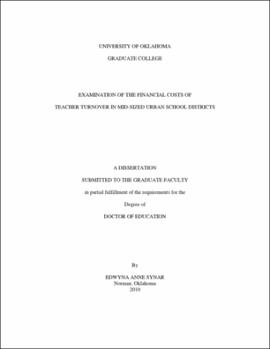| dc.contributor.advisor | Maiden, Jeffrey | |
| dc.creator | Synar, Edwyna Anne | |
| dc.date.accessioned | 2019-04-27T21:24:06Z | |
| dc.date.available | 2019-04-27T21:24:06Z | |
| dc.date.issued | 2010 | |
| dc.identifier | 99157935402042 | |
| dc.identifier.uri | https://hdl.handle.net/11244/318586 | |
| dc.description.abstract | It is estimated that 50% of beginning teachers leave the profession within the first five years on the job. When teachers depart, they take with them their knowledge of instructional techniques, students' learning styles, and professional development training. Teacher turnover creates many problems. The annual recruitment and placement of teachers is not only time-consuming and labor intensive, it is a costly burden on public school administrators. Furthermore, teachers hired to replace the teachers who have left often do not have the teaching experience and qualifications of the teachers they are replacing, and the induction of replacement teachers disrupts instructional programs until the new teachers are assimilated to the culture, curriculum, and school community. | |
| dc.description.abstract | In the past ten years, educational researchers have been trying to put a price on teacher turnover using various business and educational models. Benner put the cost between $329 million and $2.1 billion per year - for Texas alone. The Alliance for Excellent Education estimated the national yearly cost of replacing public school teachers between $2.2 billion and $4.9 billion. Finally, the National Commission of Teaching and America's Future put the national cost at $7.3 billion a year. | |
| dc.description.abstract | This study examined the various fiscal components of teacher turnover as they related to a mid-sized urban school district in the Southern United States. The purpose of this study was to validate a 4-component turnover model by calculating the financial costs of teacher turnover in an urban school district. The turnover costs were examined in four areas - separation costs of the departing teacher, hiring and training costs of the new teacher, and the development of performance productivity in the new teacher. | |
| dc.description.abstract | Utilizing terminated teacher data from school year (SY) 1999 through SY 2008, the yearly turnover costs ranged from $3.2 million in SY 2003 to $5.7 million in SY 2005, with an average yearly cost of $4.1 million. This translated into per-leaver costs ranging from $10,000 to $18,300. In addition, the yearly turnover rates averaged 9.38%, with the rates ranging from 7.55% in SY 1999 to 11.05% in SY 2004. | |
| dc.description.abstract | The future projections of yearly turnover costs for SY 2010 through SY 2012 were $4.5 million, $4.67 million, and $4.75 million respectively. In addition, the projections for yearly turnover rates for the same years were 10.60%, 10.75%, and 10.90% respectively. These calculations were determined using the Trend Line Analysis tool in Microsoft Excel. The implications are clear. The increase in teacher turnover costs also increases allocations for recruitment and hiring teachers. | |
| dc.format.extent | 158 pages | |
| dc.format.medium | application.pdf | |
| dc.language | en_US | |
| dc.relation.requires | Adobe Acrobat Reader | |
| dc.subject | Teacher turnover | |
| dc.subject | Schools--Financial costs | |
| dc.title | Examination of the Financial Costs of Teacher Turnover in Mid-Sized Urban School Districts | |
| dc.type | text | |
| dc.type | document | |
| dc.thesis.degree | Ed.D. | |
| ou.group | Jeannine Rainbolt College of Education::Department of Educational Leadership and Policy Studies | |
